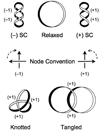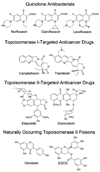DNA Topology and Topoisomerases: Teaching a "Knotty" Subject
- PMID: 19225573
- PMCID: PMC2643378
- DOI: 10.1002/bmb.20244
DNA Topology and Topoisomerases: Teaching a "Knotty" Subject
Abstract
DNA is essentially an extremely long double-stranded rope in which the two strands are wound about one another. As a result, topological properties of the genetic material, including DNA underwinding and overwinding, knotting, and tangling, profoundly influence virtually every major nucleic acid process. Despite the importance of DNA topology, it is a conceptionally difficult subject to teach, because it requires students to visualize three-dimensional relationships. This article will familiarize the reader with the concept of DNA topology and offer practical approaches and demonstrations to teaching this "knotty" subject in the classroom. Furthermore, it will discuss topoisomerases, the enzymes that regulate the topological state of DNA in the cell. These ubiquitous enzymes perform a number of critical cellular functions by generating transient breaks in the double helix. During this catalytic event, topoisomerases maintain genomic stability by forming covalent phosphotyrosyl bonds between active site residues and the newly generated DNA termini. Topoisomerases are essential for cell survival. However, because they cleave the genetic material, these enzymes also have the potential to fragment the genome. This latter feature of topoisomerases is exploited by some of the most widely prescribed anticancer and antibacterial drugs currently in clinical use. Finally, in addition to curing cancer, topoisomerase action also has been linked to the induction of specific types of leukemia.
Figures






References
-
- Watson JD, Crick FH. Genetical implications of the structure of deoxyribonucleic acid. Nature. 1953;171:964–967. - PubMed
-
- Kanaar R, Cozzarelli NR. Roles of supercoiled DNA structure in DNA transactions. Curr. Opin. Struct. Biol. 1992;2:369–379.
-
- Wang JC. DNA topoisomerases. Annu. Rev. Biochem. 1996;65:635–692. - PubMed
-
- Wang JC. Cellular roles of DNA topoisomerases: a molecular perspective. Nat. Rev. Mol. Cell Biol. 2002;3:430–440. - PubMed
-
- Bates AD, Maxwell A. New York: Oxford University Press; 2005. DNA Topology.
Grants and funding
LinkOut - more resources
Full Text Sources
Research Materials

